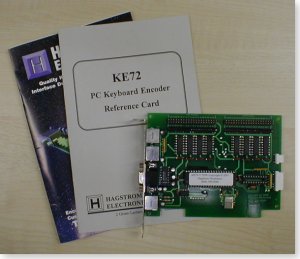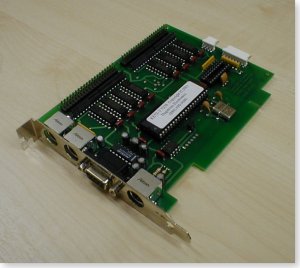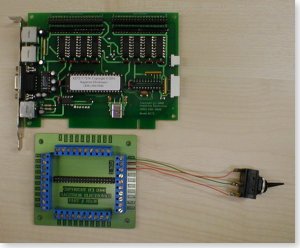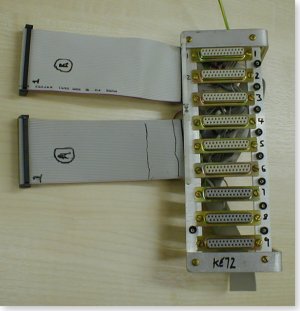|
The Hagstrom
KE72 Keyboard Encoder

Fig 1. KE72 Encoder and
Manuals
(Click on any of the images
for a larger picture)
Introduction
Building a Simpit is no
small task no matter which way you look at it, especially if you're trying
to correctly emulate a real cockpit. Having gotten the physical cockpit
construction sorted, you're left with the problem of making all those fancy
switches you've installed control your favourite simulator program. The
KE72 keyboard encoder from Hagstrom Electronics can make life very much
easier for you and at $119.95 (Jan 2002) it won't break the bank either!
The KE72 supports 72 individual
switch inputs activated using just about any form of switch including simple
push-buttons or regular toggle switches. Each input on the KE72 is programmable
using a simple configuration file, and the really smart thing is that each
switch input can be programmed to issue one or more keystrokes when the
switch contacts are closed AND/OR when they are opened. This becomes really
useful where you need to send different keystrokes for switch on and switch
off. For example, supposing your simulator uses lower case 'g' for gear
down, and upper case 'G' for gear up - the KE72 can easily be programmed
to issue the 'g' when the switch is closed, and 'G' when the switch is
opened.
The fun doesn't end here
though... the KE72 can also be programmed to issue sequences of keystrokes
including those normally awkward keys like CTRL, SHIFT and ALT. There is
a limit of 32 keystrokes when a switch is closed, and 16 when it is opened.
The KE72 has been cunningly
designed so that it will fit into a standard PCI slot in your PC (though
it uses none of the PCI connections) - this is purely for convenience and
the board may be mounted externally. The end connectors on the KE72 are
for links to the PC's keyboard port, to an external keyboard, RS232 connector
and to a trackball (KE72-T only). The 72 input connections are made by
means of two 40-way IDC connectors on the board itself.

Fig 2. KE72 Encoder Showing
End Connections
(Click on any of the images
for a larger picture)
Wiring the KE72
This is made easier using
the optional IOX36 breakout board which provides simple screw terminals
rather than the default IDC headers on the KE72 card itself. Each switch
must be wired to one of the 72 inputs, and to the common ground connection.
A simple connection using a changeover toggle switch is shown below. The
green wire is the common, and each of the orange wires goes to a KE72 input.

Fig 3. KE72 and IOX36 Showing
Basic Connection
(Click on any of the images
for a larger picture)
You can of course dispense
with the breakout board and make your own. Since my own simpit has to be
modular, I elected to make a connection panel which simply converts from
the 2 IDC connectors on the KE72 to a set of 9 25-way D-type sockets as
shown below.

Fig 4. Custom Breakout
Box
(Click on any of the images
for a larger picture)
Programming the KE72
This could not be easier,
a simple configuration file is created and downloaded to an EEPROM on the
KE72 either through the keyboard port or through the KE72's own RS232 port.
The configuration file is in plain text so you can edit it with something
as simple as Windows Notepad. Click
here to view the sample configuration file supplied with the KE72 which
contains useful comments explaining the many features available. A few
minutes browsing the example configuration will explain things far better
than I could here.
Q&A
Having spent the last year
dabbling with simpits, and with this review in mind, I emailed those friendly
folks at Hagstrom with a few questions. With their kind permission here's
what they said:
Q. Can more than
one KE72 be connected in series? (understanding that only one can be live
during programming via the keyboard interface).
A. It is possible
to connect two KE72 units in series. The main consideration here is that
the cable (keyboard cable) lengths be kept to a maximum distance of 10
feet total. The problem that arises in longer runs is that voltage is dropped
across the cable, and the end unit may not receive proper operating voltage
if the connecting cables are too long (allowing more voltage drop). The
unit attached directly to the keyboard port could be programmed through
that port. The second unit in line can be programmed through the serial
port, since that option is available as well.
Q. How susceptible
to electrical noise are the inputs? I've used shielded cable to my cockpit
switchgear, but have been concerned about noise from relays activated by
the same switches etc.
A. The KE72 inputs
are debounce in software to sort out the mechanical debounce associated
with switches. This debouncing also provides some protection against noise
generated from outside sources. The susceptibility will depend on the cable
length from the KE72 header to the end switch connection and heavily on
the environment that the unit is being operated in. Shielded cable is a
smart way to go if there is a high energy surge, such as a relay, in the
adjacent cable bundle.
Q. Have you any
plans to create an encoder with more inputs or to handle analogue-digital
control?
A. We are always
working on new products based on customer requirements. We have had a number
of requests for some type of analog input to be integrated into our devices,
so that may be a product in the future. We may also introduce an encoder
with more inputs, since that has also been a request. Some options with
present products would be to combine, say a KE72 with a KE-USB36. This
would give you two different connections (PS2 and USB) with 72 + 36 inputs.
Our KE-USB36 (which programs through USB) also has a feature which allows
two KE-USB36 devices to be attached to the same PC, but seen as two different
USB devices which may be programmed independently.
Summary:
The KE72 provides a very
simple solution to a tricky problem for any simpit builder, and does so
at a very reasonable price. Software configuration and wiring are very
easy, tech support from Hagstrom can't be faulted and taking power from
the keyboard port means one less wall-wart. If I had one criticism at all,
it would be an unfair one - there aren't enough inputs! Even with a fairly
modest simpit, 72 inputs is soon eaten up - but then at this price, just
use two KE72's!
Accessories:
-
IOX36 Breakout Board
as shown in Fig 3, this provides simple screw terminals to the many KE72
inputs. You'll need two of these if you want to use all 72 inputs.
-
KE-MM6-mini - Male-Male
cable to connect from the PC keyboard port to the KE72. (also needed by
KE72-T users to connect to the PS2 mouse port when using the Trackball
Interface).
-
KE-TBH3 Cable for connecting
to a Happ Controls Trackball.
For more info, see the accessories
page at www.hagstromelectronics.com/accessories.html
Links:
-
Hagstrom
Electronics - Hagstrom Electronics Homepage.
-
Test
Configuration - This is a test configuration file for the KE72 I used
to test my switch inputs. It simply outputs strings like 7-ON or
7-OFF
which can be very useful while debugging your wiring.
The Disclaimer:
I have no links with Hagstrom
whatsoever other than as a very satisfied customer. My order with them
was dispatched very quickly and their technical support people (thanks
Dave!) have been not only very quick to respond to my questions - but have
provided very helpful responses.
Roy Coates - January 2002
|